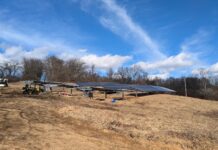Broadband advocates are urging residents to take a look at the Federal Communications Commission’s new broadband maps to check the agency’s work. These maps will determine where billions in federal funding are sent to help bridge the broadband access gap.
“Residents and businesses need to take advantage of this opportunity,” said Jason Rigone, director of Westmoreland County Planning and Development, in Pennsylvania, which oversees Westmoreland County’s Broadband Program. “More data will improve decision making. It’s going to drive and reflect where federal investment goes.”
The Federal Communications Commission released the new broadband maps on Nov. 18. Broadband advocates have long said the FCC maps overestimated the percentage of Americans with broadband access.
The previous map was divided into census blocks. So if one location in a block had service, the whole block was marked as served. The blocks are about 2 acres on average in urban areas, but could be 10-15 times larger in rural areas, according to Farm and Dairy reporting.
The new maps go into more detail, mapping out broadband service available at individual homes and businesses, using information submitted by internet service providers.
The National Telecommunications and Information Administration is using the maps to identify where federal funds from the Infrastructure Investment and Jobs Act should go. The infrastructure bill included more than $42 billion for broadband projects, including the Broadband Equity, Access and Deployment, or BEAD, program.
The deadline to review the map and submit a challenge is Jan. 13.
The FCC defines broadband internet as a minimum of 25 Mbps download and 3 Mbps upload speeds, although there is an effort underway to update that definition to 100 Mbps download and 20 Mbps upload speeds.
The maps found 98% of Pennsylvania, Ohio and West Virginia residences are covered by fixed broadband internet, meaning fiber optic, DSL or cable. The numbers drop when looking at locations covered by at least 100 mbps download and 20 mbps upload speeds. About 92% of Pennsylvania is covered, according to the FCC maps, but only 88% of Ohio and 70% of West Virginia hit that bar.
The BEAD program defines an unserved area as having at least 80% of locations within it having no broadband service or no more than 25 Mbps download and 3 Mbps upload speeds. An underserved area has 80% of its locations having between 25 Mbps and 100 Mbps for downloads and between 3 and 20 Mbps for uploads.
People can search their home or business address to make sure the information listed is accurate. The website is: broadbandmap.fcc.gov/home
The Pennsylvania Broadband Development Authority hosted a series of listening sessions, as well as two webinars in coordination with Penn State Extension, explaining the challenge process in December. The Ohio Library Council hosted a similar webinar with Broadband Ohio.
Broadband Ohio found there could be at least an additional 75,000 unserved locations, mainly in Appalachian counties, not included on the map. The agency submitted a challenge already for those locations.
Rigone said Westmoreland County is submitting a bulk challenge on behalf of its residents and businesses, but he still urges residents to check the map themselves.
“Residents and businesses have a right to go through this challenge process,” Rigone said. “It could mean the state or county getting more funding.”
State-specific challenge resources:
Pennsylvania: dced.pa.gov/programs-funding/broadband-in-pennsylvania/fcc-national-broadband-map/
West Virginia: broadband.wv.gov/west-virginians-encouraged-to-challenge-the-fcc-broadband-map-before-january-13/
(Reporter Rachel Wagoner can be reached at 724-201-1544 or rachel@farmanddairy.com.)










